![]()
Home
Aroids and other genera in the Collection
Take the Tour Now?
Orchids
The
Exotic Rainforest
I often hesitate to claim some of the plants in the Exotic Rainforest collection are rare even though they are quite rare to me! Rarity in tropical plants is to some degree a state of mind. If the plant is difficult to obtain, to a collector it can easily be considered rare. If it is hard to find in nature it is rare. If it is endangered in nature it is almost certainly rare. And if one is easy to find it can still be a rare tropical plant if it is hard to grow. As a result, its value, once a specimen is actually acquired, can be enormous.
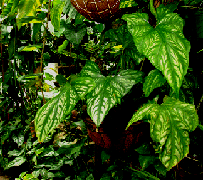 But there's more to it than
those factors. Many plants do not reproduce quickly. Either their
method of reproduction, such as Cercestis mirabilis, is
slower than with other plants or they are difficult to grow once
cuttings have been taken or seeds have been germinated. In the case
of Cercestis mirabilis,
which has leaves that appear to have been embossed with a fern, the plant is not hard to grow but it
takes a long time to get a second plant. C. mirabilis
produces a long runner which can easily take more than a year before
a single new plant can be removed! And then the new plant has to be
grown to a near adult size before it can be sold and that can be
another year! Two years to get one new plant!
Click the photo to see the plant.
But there's more to it than
those factors. Many plants do not reproduce quickly. Either their
method of reproduction, such as Cercestis mirabilis, is
slower than with other plants or they are difficult to grow once
cuttings have been taken or seeds have been germinated. In the case
of Cercestis mirabilis,
which has leaves that appear to have been embossed with a fern, the plant is not hard to grow but it
takes a long time to get a second plant. C. mirabilis
produces a long runner which can easily take more than a year before
a single new plant can be removed! And then the new plant has to be
grown to a near adult size before it can be sold and that can be
another year! Two years to get one new plant!
Click the photo to see the plant.
We have anthuriums such as the
plant we thought for years to be
Anthurium salviniae
but is actually
Anthurium schtendalii
(read the story of that rare plant by
clicking on the large anthurium photo on the homepage or click the
photo here) that require insects to pollinate
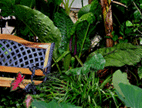 them
before you get viable seeds. You don't get viable seeds every
year. And once you get seeds to begin to grow the new
plants produce only 4 or 5 inch seedlings after a full year of
growth! In most cases it takes two years to get a descent size
plant. But when those plants are grown (years later) they can have
gigantic 5 foot plus leaves! To my way of thinking, those plants
are certainly rare because they are both slow to grow and
spectacular once grown! And are they worth the wait!
them
before you get viable seeds. You don't get viable seeds every
year. And once you get seeds to begin to grow the new
plants produce only 4 or 5 inch seedlings after a full year of
growth! In most cases it takes two years to get a descent size
plant. But when those plants are grown (years later) they can have
gigantic 5 foot plus leaves! To my way of thinking, those plants
are certainly rare because they are both slow to grow and
spectacular once grown! And are they worth the wait!
But some are "rare"
![]() (look for the rare plant icons on the list of
species on the plants collection page) simply
because specimens are not readily available. Ferns are a great
example I know a collector who
(look for the rare plant icons on the list of
species on the plants collection page) simply
because specimens are not readily available. Ferns are a great
example I know a collector who
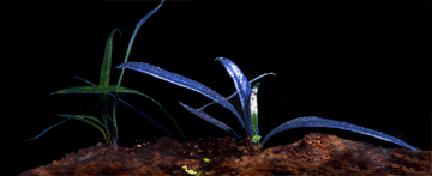 would almost kill to get a specimen
of a rare fern called Adiantum reniforme from southern
Africa, Madagascar and the Canary Islands. It is both hard to find
and hard to grow. But none are available anywhere. So far
we've found one grower who even has the plant and that grower won't
sell it! Often fern collectors pay very high prices just to be able
to find a prized fern after a long search. And many of them such
as the blue fern, Microsorum thailandicum, are very slow to reproduce and
grow thus increasing the plant's value. (click
on the photo)
would almost kill to get a specimen
of a rare fern called Adiantum reniforme from southern
Africa, Madagascar and the Canary Islands. It is both hard to find
and hard to grow. But none are available anywhere. So far
we've found one grower who even has the plant and that grower won't
sell it! Often fern collectors pay very high prices just to be able
to find a prized fern after a long search. And many of them such
as the blue fern, Microsorum thailandicum, are very slow to reproduce and
grow thus increasing the plant's value. (click
on the photo)
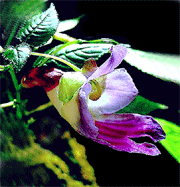 And of course
there are those plants that are downright impossible to find such as
Impatiens psittacina, The Rare Thailand Parrot Flower. (Read the story of that one
by clicking on the photo). Any rare plant collector would
pay an unheard of price for that plant!
And of course
there are those plants that are downright impossible to find such as
Impatiens psittacina, The Rare Thailand Parrot Flower. (Read the story of that one
by clicking on the photo). Any rare plant collector would
pay an unheard of price for that plant!
There are plants that used to be rare because they weren't commonly available but suddenly are in great abundance due to the tissue culture of the species. For those who may not be aware, tissue culture is simply cloning of plants by taking a piece of tissue from a near perfect plant and culturing it in a lab to produce numerous exact reproductions of the parent. As a result, many philodendrons, anthuriums, orchids and others that once easily brought $50 or more for a small plant now sell for under $20. I have a large number of such plants including very large Philodendron mamei (grown from cuttings) that cause people to raise their eyebrows when I ask $20 for a big one because they believe they can find it on eBay for $10 or less. The difference? Mine are big, most of those are very small! Before you just send the $7 find out how much plant you will get for your money! How large is the plant you can for $7 or $8 on eBay? Often you'll find that some hobbyist has bought a couple of trays of tiny 2 inch P. mamei seedlings and almost immediately put them up for sale for $7. That while more serious growers spend a year or more getting the plant to a large enough size to make it worth $20! There's not much comparison between a $7 tiny 3 or 4 inch plant with just a few leaves and a $20 one filled with fully developed leaves 7 to 8 inches across. My suggestion? Ask the seller how big the plant you will receive will be before committing to a plant! If it is going to take you a year to get it big enough to even recognize the plant species then $20 or $30 may be a bargain for one that is large already! Of course, if you enjoy sitting and watching them grow, the $7 plant may be a bargain.
Another consideration is how
is the plant you are about to acquire grown and presented? If it is
a
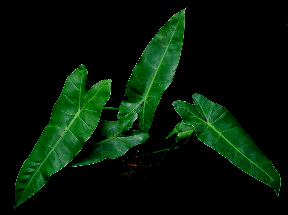 fern or aroid that is an
epiphyte (ep-a-FIT) and grows on trees and is already
attached to a nice plaque or piece of bark someone had to spend
quite a bit of time getting it attached! Often years! Even if the
grower is not a professional, they have often invested large sums of
money and time just to acquire the parent plant before even spending
the time and effort to get it to reproduce. Those growers deserve
to get something back for their investment, time and labor! A
grower's time, materials, space in the greenhouse, water, gas to
heat it in the winter, the cost of pots, fertilizer and other
materials as well as numerous other factors have value! And those
costs add to the value of a rare or semi-rare plant. But another
word of caution here! I bought a "mounted" philodendron on eBay a
year ago. Or so I thought! I paid a high price for the plant but
when it arrived it was drooping and was obviously about to die. I
cut all the fishing line the "grower" had used to tie it to the
plaque and removed mounds of orchid moss. The plant was not growing
on the plaque at all!! It was simply a fresh cutting tied to a
piece of wood! Obviously I was ticked. I had been taken and paid 4
times the value of the cutting. And I guarantee that plant seller's
web link cannot be found on my links page!
fern or aroid that is an
epiphyte (ep-a-FIT) and grows on trees and is already
attached to a nice plaque or piece of bark someone had to spend
quite a bit of time getting it attached! Often years! Even if the
grower is not a professional, they have often invested large sums of
money and time just to acquire the parent plant before even spending
the time and effort to get it to reproduce. Those growers deserve
to get something back for their investment, time and labor! A
grower's time, materials, space in the greenhouse, water, gas to
heat it in the winter, the cost of pots, fertilizer and other
materials as well as numerous other factors have value! And those
costs add to the value of a rare or semi-rare plant. But another
word of caution here! I bought a "mounted" philodendron on eBay a
year ago. Or so I thought! I paid a high price for the plant but
when it arrived it was drooping and was obviously about to die. I
cut all the fishing line the "grower" had used to tie it to the
plaque and removed mounds of orchid moss. The plant was not growing
on the plaque at all!! It was simply a fresh cutting tied to a
piece of wood! Obviously I was ticked. I had been taken and paid 4
times the value of the cutting. And I guarantee that plant seller's
web link cannot be found on my links page!
One note about " plants",
especially orchids, d at discount chains. Sure, you may
find an orchid for $12 at a discount store. But will it live? Will
it ever bloom again? Many discount sellers are selling plants that
have been forced to grow and
bloom using hormones. The hormones can
cut years off the bloom time and as a result make it er for the
discounter to and sell! An orchid takes at least 7
years from seed to first bloom if grown naturally! Those 7
years add to the value of the plant! But all
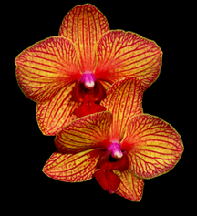 too often the
discounter's grower, interested only in turning a profit quickly for
both themselves and the retailer, use methods that cause the plant
to grow quicker but also to die prematurely! Is a $12 orchid that
will never bloom again worth the price? Is it more valuable than a
$25 orchid that blooms year after year, gets larger and larger while
reproducing new plants and gives you pleasure for 10 to 20 years? I
really don't think so. Think about it, have you ever bought
plants that should cost more but die not long after you get them
home? I sell orchids at local craft shows and often hear from folks
"You can't grow orchids! Every one I at (name of some discount
retailer) dies in just a few months". As a result of the bad
experience created by retailers hungry for quick cash by selling a
hormone grown plant another potential plant lover has been turned
off to exotic plants that actually are easy to grow!
too often the
discounter's grower, interested only in turning a profit quickly for
both themselves and the retailer, use methods that cause the plant
to grow quicker but also to die prematurely! Is a $12 orchid that
will never bloom again worth the price? Is it more valuable than a
$25 orchid that blooms year after year, gets larger and larger while
reproducing new plants and gives you pleasure for 10 to 20 years? I
really don't think so. Think about it, have you ever bought
plants that should cost more but die not long after you get them
home? I sell orchids at local craft shows and often hear from folks
"You can't grow orchids! Every one I at (name of some discount
retailer) dies in just a few months". As a result of the bad
experience created by retailers hungry for quick cash by selling a
hormone grown plant another potential plant lover has been turned
off to exotic plants that actually are easy to grow!
And one more thing to consider.
Are you
actually ing the plant you think you are ing? That will
depend on the knowledge and honesty of the seller. I know some
honest growers make mistakes, but some love to try to fool you into
ing something that is not what the plant is advertised to be! I recently
saw a plant for sale on eBay that had a name I had never
heard before, "Philodendron barryii". I thought it might be a rare plant. I looked in a
ton of books and on all the professional botany websites such
 as TROPICOS and the INTERNATIONAL PLANT NAMES INDEX and the name simply
did not exist. The seller told me that was because the plant was
"extremely rare". So rare its name could not be found on botany
sites and no reputable botanist had even heard of it? I doubted that, and I communicate regularly with some of the
best known botanists in the country and South America! But the seller also told me it
was only $9! Somehow $9 for an extremely rare plant that botanists
don't know exists just does not fit! If the botanists don't know
about it I'd be willing to pay closer to $100, perhaps more if it is
truly a rare species instead of a hybrid! In this case
the seller (knowingly or not) was using a "made-up" name for a
common plant with multiple growth forms in to sell it as
rare! I sent photos of the plant to several noted botanists and
they helped to identify it as a fairly common philodendron that has
at least 10 known growth forms. When I told the seller what I had
learned I was told "those botanists do not know what they are
talking about!" This seller continued to insist the plant was so
rare they had never heard of it. Even though noted scientists said
otherwise! Why? Because the seller would loose the ability to
misrepresent, purposely or innocently, the plant as rare. My
point? Do your research! If you can't find the name on TROPICOS or
the INTERNATIONAL PLANT NAMES INDEX the name is probably bogus!
But, just because the name is bogus does not mean the plant is not
rare. The seller may simply not know what they possess.
And in very rare cases it may truly be an unidentified species.
Dr. Tom Croat of the Missouri Botanical Garden brought back more
than 4000 unidentified aroid species from Ecuador in the summer of
2006!
as TROPICOS and the INTERNATIONAL PLANT NAMES INDEX and the name simply
did not exist. The seller told me that was because the plant was
"extremely rare". So rare its name could not be found on botany
sites and no reputable botanist had even heard of it? I doubted that, and I communicate regularly with some of the
best known botanists in the country and South America! But the seller also told me it
was only $9! Somehow $9 for an extremely rare plant that botanists
don't know exists just does not fit! If the botanists don't know
about it I'd be willing to pay closer to $100, perhaps more if it is
truly a rare species instead of a hybrid! In this case
the seller (knowingly or not) was using a "made-up" name for a
common plant with multiple growth forms in to sell it as
rare! I sent photos of the plant to several noted botanists and
they helped to identify it as a fairly common philodendron that has
at least 10 known growth forms. When I told the seller what I had
learned I was told "those botanists do not know what they are
talking about!" This seller continued to insist the plant was so
rare they had never heard of it. Even though noted scientists said
otherwise! Why? Because the seller would loose the ability to
misrepresent, purposely or innocently, the plant as rare. My
point? Do your research! If you can't find the name on TROPICOS or
the INTERNATIONAL PLANT NAMES INDEX the name is probably bogus!
But, just because the name is bogus does not mean the plant is not
rare. The seller may simply not know what they possess.
And in very rare cases it may truly be an unidentified species.
Dr. Tom Croat of the Missouri Botanical Garden brought back more
than 4000 unidentified aroid species from Ecuador in the summer of
2006!
I hope this website will prove valuable to you when doing some of that research. I always try to give the most accurate scientific names available and consult with a variety of PhD botanical experts in to do just that. I'm sure there are errors on this site, but we correct them as quickly as they are discovered! Don't just get sucked in by the word "rare"! "Rare" is unfortunately the most common word used on eBay when it comes to plants. And the majority of "rare" plants on eBay are not rare!
In most cases, I consider a plant rare if it is either hard to obtain or requires a lot of care and attention to grow and reproduce. You'll find an icon with the word "Rare" alongside a variety of plants on this site. Normally those plants took some effort to find, propagate and grow. Serious plant collectors understand why a plant has value. So do yourself and the grower a favor. Don't sneer at the price of a plant if you don't understand what the grower has gone through to acquire the plant and make it thrive. Time has value. And so do plants that truly knowledgeable growers consider Rare tropical plants! You can find trusted and honest rare plant sellers on the links page of our website which can be located at the bottom of our home page. If you don't find a seller listed there it is likely that I or someone I know has had a less than great experience with that seller! If I don't trust them, I don't list them.